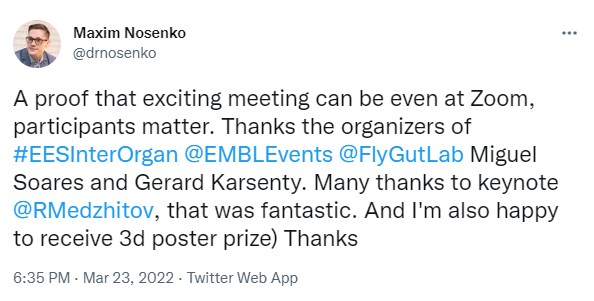Best poster prizes at ‘Inter-organ communication in physiology and disease’
Almost 40 posters were presented at the virtual EMBO | EMBL Symposium ‘Inter-organ communication in physiology and disease’, showcasing how studies in model organisms are revealing novel inter-organ signals that contribute to whole-organism homeostasis. There were two live poster sessions and the presenters could also be contacted via chat, message or video call throughout the conference – their work was then voted for by other attendees and speakers. We are pleased to be able to share with you the research from the three winners of the best poster prizes: congratulations to Emily, Wilson and Maxim!
1st prize: Sex and reproductive differences in gut tumours
Presenter: Emily Strachan
Due to data protection regulations, we cannot publish the poster.
2nd prize: A protective neuro-adipose tissue axis against malaria
Presenter: Temitope Wilson Ademolue

Abstract
Infections lead to the development of host sickness behavior. This evolutionarily conserved response includes the withdrawal of the infected host from food, known as anorexia. This behavior limits the exogenous supply of metabolic substrates; and in the absence of a countervailing metabolic response, anorexia can lead to starvation and death. We reasoned that the infected host relies on the mobilization of stored metabolic substrates to minimize the deleterious effects of anorexia. Presumably, this is required to sustain vital metabolic processes compatible with survival. Using a non lethal rodent model of malaria, we show that Plasmodium infected mice progressively developed anorexia of infection. This was coupled to a profound loss of white adipose tissue via adipose tissue triglyceride lipase (Atgl) driven lipolysis; and was associated with the mobilization of free fatty acids, induction of ketogenesis, and triglyceride synthesis. The Inhibition of adipose tissue lipolysis via Atgl deletion specifically in adipocytes increased malaria mortality. This was associated with compromised thermoregulation and the collapse of organismal energy expenditure, indicating that mobilization of fat stores via lipolysis is essential to survive Plasmodium infection. Mechanistically, malaria induced lipolysis is controlled by the central nervous system as demonstrated using chemo genetically sympathectomized mice, lacking the peripheral arm of the sympathetic nervous system. In the absence of sympathetic outflow, Plasmodium infected mice failed to mobilize adipose tissue depots and to maintain energy expenditure, succumbing to malaria. In conclusion, we show that survival from malaria relies on metabolic response and adaptation that is coordinated by the sympathetic nervous system.
3rd prize: Skeletal muscle-derived IL-6 orchestrates physiological adaptations in the context of inflammation
Presenter: Maxim Nosenko

Abstract
Survival during infections relies on multiple resistance and tolerance mechanisms and requires the most adaptive response being launched based on the disease setting. While many immunological pathways, distinguishing pathogen type and localization, have been discovered, less is known about the mechanisms, sensing different stages of the infection, especially transition from local to systemic disease. The latter can be life threatening in situations such as sepsis or severe COVID 19, and thus tolerance mechanisms become crucial. Inflammatory cytokines, including IL 6, are believed to govern both immune response and adaptation in the context of infection. However, the mechanisms of tolerance induction are still poorly investigated.
To address this question, we employed a mouse model of LPS induced sepsis and analysed physiological response of the animals as well as proinflammatory cytokines production. Administration of LPS resulted in fatigue, hypoglycaemia, and hypothermia, that were associated with predominant accumulation of IL 6 in the blood. To address the role of IL 6 we employed knock out mice and observed a significant suppression of fatigue, increased blood glucose level and core temperature. Surprisingly, conditional inactivation of IL 6 in myeloid cells did not affect systemic cytokine accumulation in response to LPS. We next performed screening across tissues and found only skeletal muscles showing high expression of IL 6 gene in response to LPS, independently of IL 6 production by myeloid cells. Further investigation revealed a key role of IL 6 in reprogramming of glycogen metabolism in the liver upon LPS challenge, resulting in hypoglycaemia. Recent studies indicated the positive effect of hypoglycaemia during bacterial sepsis, suggesting that IL 6 mediates adaptation to this condition.
Altogether, we hypothesize that skeletal muscles are key systemic inflammation sensing organs, responsible for accumulation of IL 6 and induction of physiological adaptations. Further investigation of the role of IL 6 in the context of local and systemic inflammation could bring novel therapeutic opportunities for induction of the tolerance in life threatening infectious diseases.

Congratulations to all three winners!
The EMBO | EMBL Symposium ‘Inter-organ communication in physiology and disease’ took place from 21 – 23 March 2022.